
The tiger is the largest living cat species and a member of the genus Panthera. It is most recognisable for its dark vertical stripes on orange fur with a white underside. An apex predator, it primarily preys on ungulates, such as deer and wild boar. It is territorial and generally a solitary but social predator, requiring large contiguous areas of habitat to support its requirements for prey and rearing of its offspring. Tiger cubs stay with their mother for about two years and then become independent, leaving their mother's home range to establish their own.

The clouded leopard, also called the mainland clouded leopard, is a wild cat inhabiting dense forests from the foothills of the Himalayas through mainland Southeast Asia into South China. In the early 19th century, a clouded leopard was brought to London from China and described in 1821. It has large dusky-grey blotches and irregular spots and stripes reminiscent of clouds. Its head-and-body length ranges from 68.6 to 108 cm with a 61 to 91 cm long tail. It uses its tail for balancing when moving in trees and is able to climb down vertical tree trunks head first. It rests in trees during the day and hunts by night on the forest floor.
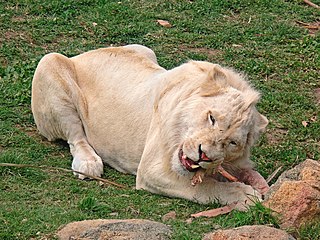
The white lion is a rare color mutation of the lion, specifically the Southern African lion. White lions in the area of Timbavati are thought to have been indigenous to the Timbavati region of South Africa for centuries, although the earliest recorded sighting in this region was in 1938. Regarded as divine by some African cultures, white lions first became known to the English-speaking world in 1977 through the book The White Lions of Timbavati.

Save China's Tigers (SCT) is an international charitable foundation based in Hong Kong, the United States, and the United Kingdom which aims to save the big cats of China from extinction. It focuses on the Chinese tigers. It also has branches in Mainland China and South Africa.

Thailand's dramatic economic growth has caused numerous environmental issues. The country faces problems with air, declining wildlife populations, deforestation, soil erosion, water scarcity, and waste issues. According to a 2004 indicator, the cost of air and water pollution for the country scales up to approximately 1.6–2.6% of GDP per year. As such, Thailand's economic growth has come at great cost in damage to its people and environment.

The Indian leopard is a leopard subspecies widely distributed on the Indian subcontinent. The species Panthera pardus is listed as Vulnerable on the IUCN Red List because populations have declined following habitat loss and fragmentation, poaching for the illegal trade of skins and body parts, and persecution due to conflict situations. The Indian leopard is one of the big cats occurring on the Indian subcontinent, along with the Asiatic lion, Bengal tiger, snow leopard and clouded leopard. In 2014, a national census of leopards around tiger habitats was carried out in India except the northeast. 7,910 individuals were estimated in surveyed areas and a national total of 12,000-14,000 speculated.
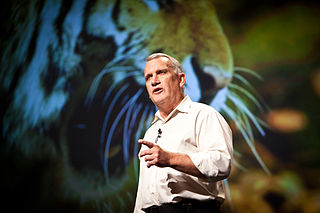
Alan Robert Rabinowitz was an American zoologist who served as the president, CEO, and chief scientist at Panthera Corporation, a nonprofit conservation organization devoted to protecting the world's 40 wild cat species. Called the "Indiana Jones of Wildlife Protection" by Time, he studied jaguars, clouded leopards, Asiatic leopards, tigers, Sumatran rhinos, bears, leopard cats, raccoons, and civets.

Wildlife trade refers to the commerce of products that are derived from non-domesticated animals or plants usually extracted from their natural environment or raised under controlled conditions. It can involve the trade of living or dead individuals, tissues such as skins, bones or meat, or other products. Legal wildlife trade is regulated by the United Nations' Convention on International Trade in Endangered Species of Wild Fauna and Flora (CITES), which currently has 184 member countries called Parties. Illegal wildlife trade is widespread and constitutes one of the major illegal economic activities, comparable to the traffic of drugs and weapons.
The tiger is an iconic species. Tiger conservation attempts to prevent the animal from becoming extinct and preserving its natural habitat. This is one of the main objectives of the international animal conservation community. The Convention on International Trade in Endangered Species of Wild Fauna and Flora (CITES) has played a crucial role in improving international efforts for tiger conservation.
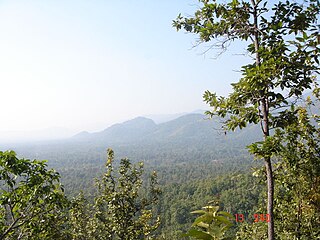
The Huai Kha Khaeng Wildlife Sanctuary is in Uthai Thani and Tak Provinces, Thailand. The park was established in 1974, and is part of the largest intact seasonal tropical forest complex in Mainland Southeast Asia. It, coupled with the Thungyai Naresuan Wildlife Sanctuary was declared a World Heritage Site by the United Nations in 1991. Together, the two sanctuaries occupy 622,200 hectares. As of 2014 it still contained viable populations of large mammals, including gibbons, bears, elephants and Indochinese tigers, although like all other sites in mainland Southeast Asia, some species have disappeared or have experienced severe declines.
The EAZA Ex-situ Programme (EEP), formerly known as European Endangered Species Programme, is a population management programme for animals of the European Association of Zoos and Aquaria (EAZA). It is one of the worldwide assembly of such regional breeding programs for threatened species in zoos. The North America counterpart is the Species Survival Plan (SSP); Australian, Japanese, Indian, and Chinese zoos also have similar programs. Combined, there are now many hundred zoos worldwide involved in regional breeding programs. Each EEP has a coordinator who is assisted by a species committee. The coordinator collects information on the status of all the animals kept in EAZA zoos and aquariums of the species for which he or she is responsible, produces a studbook, carries out demographic and genetic analyses, produces a plan for the future management of the species and provides recommendations to participating institutions. Together with the Species Committee, recommendations are made each year about relocating and breeding animals, and the conditions of such a move.

An endangered species is a species that is very likely to become extinct in the near future, either worldwide or in a particular political jurisdiction. Endangered species may be at risk due to factors such as habitat loss, poaching and invasive species. The International Union for Conservation of Nature (IUCN) Red List lists the global conservation status of many species, and various other agencies assess the status of species within particular areas. Many nations have laws that protect conservation-reliant species which, for example, forbid hunting, restrict land development, or create protected areas. Some endangered species are the target of extensive conservation efforts such as captive breeding and habitat restoration.
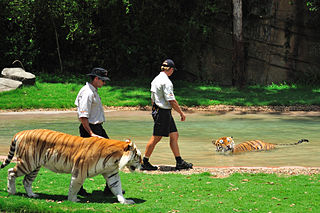
Tiger Island is a wildlife attraction at the Dreamworld amusement park on the Gold Coast, Queensland, Australia. In April 2019, the area was home to eight adult tigers and three cubs. This exhibit is home to both the Bengal and Sumatran tiger species.
The ASEAN Wildlife Enforcement Network (ASEAN-WEN) was officially launched on 1 December 2005, as a regional inter-agency and inter-governmental initiative to counter the illegal cross-border trade in endangered flora and fauna. It helps countries share information on and tackle cross-border wildlife crime and facilitates the exchange of regional best practices in combating those crimes. As the world's largest wildlife law enforcement network, it comprises the law enforcement agencies of the 10 ASEAN countries forming a regional intergovernmental law-enforcement network.
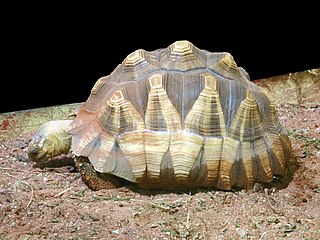
The angonoka tortoise is a critically endangered species of tortoise severely threatened by poaching for the illegal pet trade. It is endemic to Madagascar. It is also known as the angonoka, ploughshare tortoise, Madagascar tortoise, or Madagascar angulated tortoise. There may be less than 400 of these tortoises left in the wild. It is found only in the dry forests of the Baly Bay area of northwestern Madagascar, near the town of Soalala .A captive-breeding facility was established in 1986 by the Jersey Wildlife Preservation Trust in collaboration with the Water and Forests Department. In 1996, 75 tortoises were stolen, which later appeared for sale in the Netherlands. The project was ultimately successful, achieving 224 captive-bred juveniles out of 17 adults in 2004. Project Angonoka developed conservation plans that involved local communities making firebreaks, along with the creation of a park to protect the tortoise and the forests. Monitoring of the angonoka tortoise in the global pet trade has also continued to be advocated.
Bor Tiger Reserve is a wildlife sanctuary which was declared as a tiger reserve in July 2014. It is located near Hingani in Wardha District in the Indian state of Maharashtra. It is a home to a variety of wild animals. The reserve covers an area of 138.12 km2 (53.33 sq mi). which includes the drainage basin of the Bor Dam.

Animal welfare in Thailand relates to the treatment of animals in fields such as agriculture, hunting, medical testing, tourism, and the domestic ownership of animals. It is distinct from animal conservation.

Wildlife Friends Foundation Thailand (WFFT) is a registered foundation (non-profit) NGO in Thailand, founded in 2001 by Edwin Wiek. The foundation has several different projects including animal rescue, rehabilitation and veterinary assistance to wild animals in Thailand. It also is active in promoting the protection of wildlife, their natural habitat and the natural environment. This is done through educational initiatives for local Thai people as well as tourists. WFFT operate a rescue center and wildlife refuge, including an Elephant refuge. WFFT responds to reports by the public and government officials of wildlife in need of care. Many of these rescued wild animals are kept as pets illegally, or are found injured. WFFT is known for their public stand against the so-called Tiger Temple and its ongoing violations of laws regarding keeping protected wildlife.

Tiger bone wine is an alcoholic beverage originally produced in China using the bones of tigers as a necessary ingredient. The production process takes approximately eight years and results in a high alcohol concentration. According to traditional Chinese medicine, the specific use of certain body parts is capable of healing diseases according to the characteristics of the animal used to obtain the product, that is believed to be connected with the disease of the person.
Steven R. Galster is an American environmental and human rights investigator and counter-trafficking program designer. Since 1987, he has planned and participated in investigations and remedial programs to stop wildlife and human trafficking and to mitigate corruption and build governance in Asia, Africa, Russia, South America, and the USA.

















